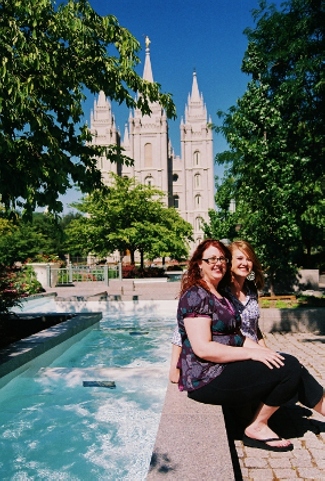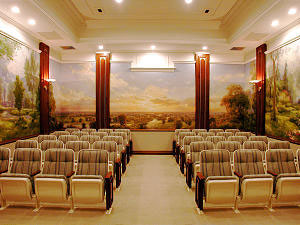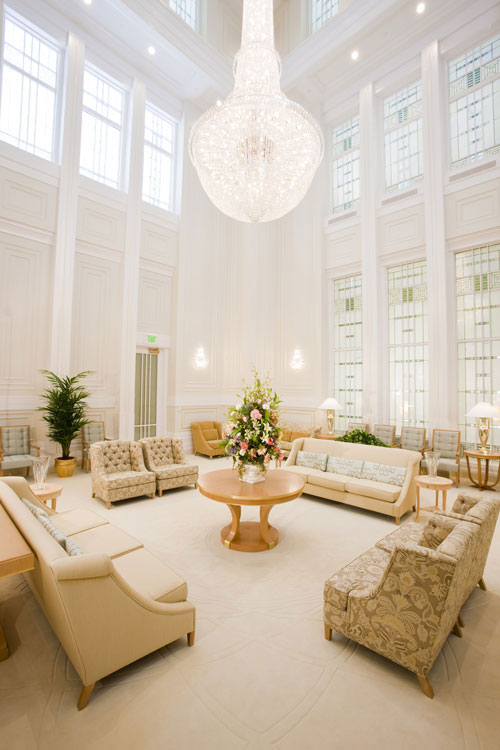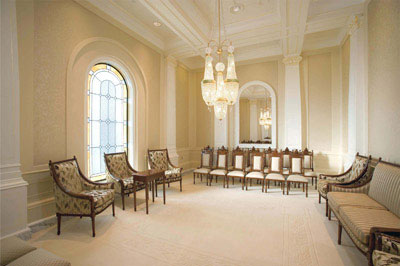Mormon Endowment
Contents
- 1 Introduction
- 2 Mormon Endowment
- 3 Mormon Endowment: Complete in its Course of Instruction
- 4 The Truth About the Mormon Endowment: Sacred Not Secret
- 5 What Follows the Mormon Endowment: Eternal Marriage in Mormon Temples
- 6 Blessings of Mormon Temple Worship, Rituals, & The Mormon Endowment
- 7 External Links
Introduction
The Mormon endowment is one of several rites or ordinances that take place, under the Savior’s direction and by His authority, in temples of The Church of Jesus Christ of Latter-day Saints.
The holy temple is a compelling place of peace, beauty, and worship for Latter-day Saints (Mormons). It is literally the Savior’s House on earth, a House of the Lord, wherein those who worship are taught, empowered, and directed as they carve out their mortal course back to our Heavenly Home. Mormon temples, as sacred precincts, are central, key even, to the eternal purposes of God for each of His children on earth. All are invited to enter who will prepare themselves and comply with the Savior’s pre-requisites. Within these holy courts of The Church of Jesus Christ of Latter-day Saints (Mormon temples), those of God’s children who spiritually prepare and qualify, are baptized for loved deceased relatives, endowed through the Mormon endowment described below, and sealed together forever as families. There they are filled beyond measure with His power, peace, and presence sustaining and abiding with them in their daily walk as Christian disciples. There they receive ordinances that enable them to return to God’s presence.
As Mormon Christians enter God’s sanctuary or temple, they engage in sacred rites or ordinances--instruction and covenant-making processes, if you will—conducted by God’s authorized servants, necessary for eternal life in God’s presence. Covenants, in Mormonism, are viewed as two-way promises between our Heavenly Father and His children. Ordinances, in Mormon doctrine, are outward symbols of an inward commitment (such as baptism and confirmation). These ordinances take place in respective rooms or settings in the Lord’s House, each meticulously designed, immaculately kept, pristinely lit, Spirit-filled. These include the beautiful and symbolic baptistery, initiatory areas, Mormon endowment rooms, and sealing altars. Officiators set apart for temple work preside and serve and minister to patrons who attend; they operate under a Temple Presidency, called of God by a living prophet. Temple ordinances enlighten and equip Mormons for this life and prepare them and others who accept these ordinances performed in their behalf, for a joyful, glorious existence with redeemed loved ones hereafter.
In committing to live higher moral and spiritual laws in Mormon temples, and in receiving symbolic and literal instruction through the Mormon endowment, members of The Church of Jesus Christ are able to claim commensurate promised blessings realized hourly and daily, for now and eternity. These include increased impetus and grace in overcoming challenges and navigating all of life’s circumstances; spiritual protection for themselves and their children; ministering of angels; power; outpourings of knowledge; sanctification or the ability to become more and more like the Savior, and, ultimately, to behold His face. These beautiful and real blessings—truly divine gifts or “endowments”—are accessible by virtue of and through the atoning and healing power and authority that flows from Jesus Christ Himself and His courts. As recorded in the Bible,
- “Those that be planted in the house of the Lord shall flourish in the courts of our God (Psalms 92:13).
Mormons truly find joy in serving in God’s holy temples, restored in our day in the fullness of gospel times.
Mormon Endowment
There are many ordinances that occur in the Savior’s House (LDS/”Mormon” temples). An endowment, then--often referred to by friends of other faiths as the Mormon endowment, Mormon temple ceremony, or Mormon temple ritual--is one of a number of these crowning gospel ordinances. Other ordinances include baptism for the dead, through which a merciful God allows those who have died without a knowledge of the gospel to receive it by proxy; marriage sealings in which couples are united in marriage forever; as well as washing, anointing, and clothing ordinances, also known as the Mormon initiatory. (The washing and anointing is symbolic, using a drop of water and drop of oil.) The initiatory ordinances are considered preparatory to and part of the Mormon endowment ceremony. During the initiatory, members are also spiritually cleansed, given gifts of renewal and spiritual protection through the Spirit, blessings that precede the fuller endowment. They are also clothed with the Mormon holy garment, a beautiful and simple reminder of their covenants, worn under everyday clothing outside of the temple and within its walls. (Garment is the appropriate term; “Mormon underwear” is a casual, much less respectful term coined generally by those who make light of this sacred practice.)
The Mormon endowment itself takes place in about an hour-and-a-half temple session and involves a two-way, personal exchange of covenants or promises between the temple-attendee or patron and the Lord. A member of the Savior’s Church enters, changes into white clothes (leaving the vestments of the world behind); women wear modest, sleeved dresses and the men, white pants and white shirt--symbolic both of purity of soul and members’ equal footing as children of Heavenly Parents. Each patron comes seeking to learn, serve, and make promises to God and the Savior. The Mormon endowment includes a film or live presentation of the plan of happiness or plan of salvation from the Creation to eternal life in God’s presence.
It includes extended learning about the Garden of Eden, the path to reconciliation with God and Jesus Christ, the atonement, the apostasy, the strategies of Lucifer, the restoration of the gospel in its fullness, and the pre-requisites for personal purity and wholehearted devotion to God. During this time of learning, members ponder and relate to the teachings through the Spirit who attends them. Mormons often find solutions to vexing problems come as they engage in this spiritual process. In the words of a living apostle, Boyd K. Packer:
- At the temple the dust of distraction seems to settle out, the fog and the haze seem to lift, and we can ‘see’ things that we were not able to see before and find a way through our troubles that we had not previously known.
Temple patrons also pause at specific points within the Mormon endowment to commit to obey the highest, most exalting, and complete laws of the gospel, in a progressive fashion, and in return, receive God’s promises of His supernal blessings for this life and the next. These laws are freeing and edifying, for all who embrace them willingly.
Ordinances are outward expressions of an inner commitment. When they are performed with Christ’s authority, and not simply a professed assumption of that authority, they are life-changing and do bring truths to our mind and hearts that alter our perspective and increase our vision and spiritual tenacity. One late prophet of God, Brigham Young, encapsulated the Mormon endowment in these words:
- Let me give you a definition in brief. Your endowment is to receive all those ordinances in the House of the Lord, which are necessary for you, after you have departed this life, to enable you to walk back to the presence of the Father, passing the angels who stand as sentinels, being able to give them the key words, the signs and tokens, pertaining to the holy Priesthood, and gain your eternal exaltation in spite of earth and hell. (Discourses of Brigham Young, comp. John A. Widtsoe, Salt Lake City: Deseret Book Co., 1971).
Mormon Endowment: Complete in its Course of Instruction
One late Mormon scholar acknowledged the perfect blend of thought and feeling that occurs in the temple as we learn about our eternal destinies, and remarked that he wished we had a word for it, like “compre-feel.” In the ordinances, “a symphonic combination of all aspects of the self occurs,” he aptly records (Truman Madsen, The Highest in Us, p.39). Ordinances, as Madsen suggests, also trigger spiritual memories and enable us to tap into a reservoir of strength and knowledge that has come with us here and that the Savior has provided through His atoning sacrifice for our sins. The manner of teaching in the temple is the Master’s. It is sublime. One never ceases to learn in the House of the Lord (Mormon temples) just as one never ceases to learn from the scriptures.
A late Church leader testifies to the cohesive nature of the endowment:
- The temple ordinances encompass the whole plan of salvation, as taught from time to time by the leaders of the Church, and elucidate matters difficult of understanding. There is no warping or twisting in fitting the temple teachings into the great scheme of salvation The philosophical completeness of the endowment is one of the great arguments for the veracity of the temple ordinances. Moreover, this completeness of survey and expounding of the Gospel plan, makes temple worship one of the most effective methods in refreshing the memory concerning the whole structure of the Gospel (Utah Genealogical and Historical Magazine, Apr. 1921, p. 58).
The Truth About the Mormon Endowment: Sacred Not Secret
Just as Andrew Skinner explains clearly in his work, Temple Worship, it shouldn’t surprise us that the Lord has a requirement of purity to enter His House, a House of the Lord--or “temple”-- built to His glory and to our edification. Quoting Brother Skinner:
- Because Latter-day Saint temples possess the same degree of sanctity and holiness as ancient temples--where the Lord appeared--the same degree of worthiness is required of every invited guest today as anciently. Consider the standard set forth in Ezekiel 44:9: Thus saith the Lord God: No stranger, uncircumcised in heart, nor uncircumcised in flesh, shall enter into my sanctuary, or any stranger that is among the children of Israel.’
- Just as ancient Israel could not, by divine decree, allow any stranger to enter God’s holy home, so too modern Israel, by divine decree, cannot allow any stranger to enter God’s holy home. Wealth or worldly position count for nothing if individuals are not recognized as legitimate invited guests by the Master of the house or his authorized servants (Deseret Book, 2005, p.155).
The Savior walks the halls of His house. He asks us to be striving disciples, and to be obedient to what He’s asked of us, as a pre-requisite for entering His house. Anyone who complies and is temple-worthy may enter His house. No one is not invited to participate in baptisms for the dead, the Mormon endowment, or temple sealings; it’s just that the invitation requires His signature through an authorized representative, by way of what is known as a ‘recommend,’ an affidavit that the individual about to enter the temple is living as best as they can in compliance with the laws of the gospel. As Jesus Christ Himself declares in modern revelation:
- For all who will have a blessing at my hands shall abide the law which was appointed for that blessing, and the conditions thereof, as were instituted from before the foundation of the world (D&C 132:4-5).
What Follows the Mormon Endowment: Eternal Marriage in Mormon Temples
Eternal marriage, rather than a couple’s civil union that expires at death, is a spiritual teaching in the Savior’s true and living Church (The Church of Jesus Christ of Latter-day Saints which friends may know us, through media error, as the Mormon Church). Joseph Smith—Mormon prophet in the Savior’s hands to restore His teachings to the earth in our day—taught that:
- [Eternal Marriage] was an institution of heaven, instituted in the Garden of Eden; [and] that it is necessary it should be solemnized by the authority of the everlasting priesthood (Doctrines of Salvation, 2:70).
Adam and Eve were joined or “sealed” together forever by the power of God in the Garden of Eden. And, like Adam and Eve, we each will have the opportunity to participate in marriage sealing ceremony in a sacred setting in Mormon temples— Houses of God--personally or by proxy- in order to have bestowed on us the powers, blessings, promises for an exalted, glorious life hereafter. This is a true doctrine that Mormons espouse as revealed from God in our day, and as restored truth on the earth for all to hear and claim. Family relationships are meant to be eternal and while there will be, through agency, some missing links in the chain, the family at large will be brought together and exalted by this priesthood ordinance and those that precede it.
Late apostle of Jesus Christ, Bruce McConkie, speaks helpfully to the requirements for eternal marriage, which follows, for those marrying, the Mormon endowment:
- In order to get a proper marriage one must do this: first, search for and seek out celestial marriage—find the right ordinance; second, look for a legal administrator, someone who holds the sealing power—and that power is exercised only in the temples that the Lord has had built by the tithing and sacrifice of His people in our day; and third, so live in righteousness, uprightness, integrity, virtue and morality that he is entitled to have the Holy Spirit of God ratify and seal and justify and approve, and in that event his marriage is sealed by the Holy Spirit of promise and is binding in time and eternity (New Era, “Celestial Marriage,” June, 1978).
Blessings of Mormon Temple Worship, Rituals, & The Mormon Endowment
It is through service and pure worship in LDS (“Mormon”) temples that Christ’s followers--worthy, striving Mormons and those who become so through baptism into His Church--gain knowledge at an accelerated rate through His Spirit, increase in knowledge and perspective regarding their identity, their purpose on earth, in the here and now, the reality of life before birth, and receive compelling reminders of their divine destinies—which are more glorious than even many Christians of other faiths might suppose. It is in this, His House, and through this covenant-exchanging Mormon Endowment that attendees, invited guests in the Lord’s house, receive promised divine power that far exceeds an individual’s own resources, boosts his or her spiritual and temporal progress, impacts and provides spiritual protection for themselves, their children, and family members in significant ways, tempers appetites for worldly things, inspires and propels faithful followers forward in their respective daily walk with Christ and kingdom building efforts, and furthers them significantly in their quest for and ultimate assurance of eternal life.
Temple worship fills the spiritual hunger and longing for God that is part of our spiritual birthright as His children. It is an invitation to have that hunger satisfied in His presence, to learn how to ascend to His presence. Its gifts fill us with what the world cannot, what the biggest and best enterprise, most extravagant shopping spree, applause, medals, cannot alone provide. It fills like only God’s sacred ordinances, teachings, and worship in His house can do. In the words of a living prophet:
- As a result of sacred ordinances performed in the holy house of God, no light need be permanently extinguished, no voice permanently stilled, no place in our heart permanently let vacant (Thomas Monson, Be Your Best Self, 54).
Through temple service —including the Mormon endowment and marriage sealing — answers to the questions of the soul are provided and verified, the plan laid out in symbolic fashion, and everyone receives what is needed to eventually part the veil of mortality and return to God’s presence.
We will face God again! We can be prepared. All of the truths, processes, and authority we need to work out our salvation here and re-enter His presence, are on the earth. No wonder the angel sounds the trump, figuratively, from the top of nearly every Mormon temple. Truly, this is a glorious message for all the world.
External Links
Some individual temples:
- The Boston Massachusetts Mormon Temple
- The Rome Italy Mormon Temple
- The Philadelphia Pennsylvania Mormon Temple
- The Indianapolis Indiana Mormon Temple
Visit a Mormon Temple



